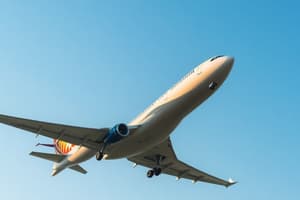Podcast
Questions and Answers
What is the primary function of a propeller on an aircraft?
What is the primary function of a propeller on an aircraft?
- Generate lift
- Provide thrust (correct)
- Create drag
- Stabilize the aircraft
What does the angle of attack refer to?
What does the angle of attack refer to?
- The angle between fuselage axis and wing chord length
- The asymmetry between the top and bottom curves of an airfoil
- The angle between one of the wings and horizontal plane
- The angle the wind makes with the wing (correct)
Which term refers to the shape of an airfoil that conforms to the streamlines of the flow?
Which term refers to the shape of an airfoil that conforms to the streamlines of the flow?
- Dihedral Angle
- Camber line (correct)
- Angle of Attack
- Angle of Incidence
Which type of aircraft is likely to have a high camber airfoil?
Which type of aircraft is likely to have a high camber airfoil?
What is the term for the angle between one of the wings and the horizontal plane?
What is the term for the angle between one of the wings and the horizontal plane?
In terms of aerodynamics, what does a high camber airfoil help achieve?
In terms of aerodynamics, what does a high camber airfoil help achieve?
Which term represents the angle between fuselage axis and wing chord length?
Which term represents the angle between fuselage axis and wing chord length?
What is a propeller's role in relation to an aircraft's motion?
What is a propeller's role in relation to an aircraft's motion?
What effect does a high angle of attack have on an aircraft's performance?
What effect does a high angle of attack have on an aircraft's performance?
Flashcards are hidden until you start studying
Study Notes
What is Aerodynamics?
- Deals with the motion and forces acting on a body moving in air
- Concerned with the study of the interaction between air and solid objects
How Do Airplanes Fly?
- 4 aerodynamic forces act on an airplane in flight: thrust, drag, lift, and weight
- Conditions for flight: thrust > drag, lift > weight
- In straight and level flight, lift and weight are balanced
- During descent, gravity exceeds lift, and drag must overcome thrust
Forces Acting on a Plane
- Weight: weight of the airplane acts downwards due to gravity, should be minimized
- Thrust: mechanical force generated by the engine to move the aircraft forward
- Lift: mechanical force generated by a solid object moving through a fluid, acts perpendicular to the direction of fluid flow
- Drag: resisting force to the motion of the aircraft due to its relative motion with air flow
Formulas
- Lift formula: L = 1/2 ρ A V²C_L
- Drag formula: D = ρV²C_D/2
- Bernoulli's equation: (P/ ρg) + (V²/2g) + Z = const
Motion of an Airplane
- Pitch motion: up and down movement of the nose
- Rolling motion: rotation around the longitudinal axis
- Yaw motion: rotation around the vertical axis
Basic Parts of an Airplane
- Fuselage: main body of the airplane, houses the flight crew, passengers, and cargo
- Wings: generate lift due to the difference in curvature of the upper and lower parts
- Tail: provides stability and control to the vertical up-down movement of the nose
- Stabilizers: keep the aircraft in straight-and-level flight
- Elevators: control the climb or descent of the aircraft
- Rudder: defines horizontal flight and provides directional control
- Ailerons: control the rolling (or banking) motion of the aircraft
- Flaps: increase lift during takeoff and landing
- Propeller: provides thrust to the aircraft
- Airfoil: shape that conforms to the streamlines of the flow and prevents wake formation
Wing Generation of Lift
- Lift is generated by the difference in pressure above and below the wing
- Airfoil shape produces better lift than any other form of the wing
- Camber line: line joining the leading and trailing edges of an airfoil equidistant from the upper and lower surfaces
- Camber: asymmetry between the top and the bottom curves of an aerofoil in cross-section
- Angle of incidence: angle between the fuselage axis and the wing chord length
- Angle of attack: angle the wind makes with the wing (relative wind)
- Dihedral angle: angle between one of the wings and the horizontal plane in which the fuselage axis is situated
Studying That Suits You
Use AI to generate personalized quizzes and flashcards to suit your learning preferences.




